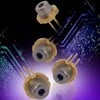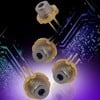Help with Diode Lasers specifications:
Laser Type
Back to Top
|
|
| ||
| Your choices are... | |||
| Laser Diodes | Laser diodes use light-emitting diodes to produce stimulated emissions in the form of coherent light output. They are also known as diode lasers. | ||
| Laser Diode Modules | Laser diode modules use light-emitting diodes to produce stimulated emissions in the form of coherent light output and include integrated beam optics and electrical systems. | ||
| Search Logic: | All products with ANY of the selected attributes will be returned as matches. Leaving all boxes unchecked will not limit the search criteria for this question; products with all attribute options will be returned as matches. | ||
| Tunable Laser | Tunable lasers have an external cavity that can be adjusted to emit one of several different wavelengths, usually on the ITU-Grid. | ||
| Search Logic: | "Required" and "Must Not Have" criteria limit returned matches as specified. Products with optional attributes will be returned for either choice. | ||
Laser Output
Back to Top
|
|
| ||
| Laser Output: | |||
| Your choices are... | |||
| Continuous Wave | The laser output is continuous. | ||
| Pulsed | The laser output is pulsed. | ||
| Search Logic: | All products with ANY of the selected attributes will be returned as matches. Leaving all boxes unchecked will not limit the search criteria for this question; products with all attribute options will be returned as matches. | ||
| Laser Wavelength: | |||
| Your choices are... | |||
| Ultraviolet | The laser has output corresponding to the ultraviolet region of the spectrum. Ultraviolet is considered the wavelength range from 1 nm to 390 nm. | ||
| Violet | The laser has output corresponding to the violet region of the spectrum. Violet is considered the wavelength range from 390 nm to 455 nm. | ||
| Blue | The laser has output corresponding to the blue region of the spectrum. Blue is considered the wavelength range from 455 nm to 492 nm. | ||
| Green | The laser has output corresponding to the green region of the spectrum. Green is considered the wavelength range from 492 nm to 577 nm. | ||
| Yellow | The laser has output corresponding to the yellow region of the spectrum. Yellow is considered the wavelength range from 577 nm to 597 nm. | ||
| Orange | The laser has output corresponding to the orange region of the spectrum. Orange is considered the wavelength range from 597 nm to 622 nm. | ||
| Red | The laser has output corresponding to the red region of the spectrum. Red is considered the wavelength range from 622 nm to 780 nm. | ||
| Infrared | The laser has an output which corresponds to the infrared (IR) portion of the electromagnetic spectrum. Infrared is the wavelength range from .78 μm to 1000 μm. | ||
| Other | Other unlisted or specialized wavelengths. | ||
| Search Logic: | All products with ANY of the selected attributes will be returned as matches. Leaving all boxes unchecked will not limit the search criteria for this question; products with all attribute options will be returned as matches. | ||
| Wavelength Range | The wavelength(s) the laser produces. | ||
| Search Logic: | User may specify either, both, or neither of the "At Least" and "No More Than" values. Products returned as matches will meet all specified criteria. | ||
| Laser Power | Laser power is measured in watts (W) and indicates the strength of a laser beam. A watt is one joule of energy per second. | ||
| Search Logic: | User may specify either, both, or neither of the "At Least" and "No More Than" values. Products returned as matches will meet all specified criteria. | ||
Beam Specification
Back to Top
|
|
| ||
| Beam Area | Beam area refers to the area of the beam when exiting the laser. | ||
| Search Logic: | User may specify either, both, or neither of the "At Least" and "No More Than" values. Products returned as matches will meet all specified criteria. | ||
| Beam Divergence | Beam divergence refers to the change in beam diameter as a function of distance from the laser. | ||
| Search Logic: | User may specify either, both, or neither of the "At Least" and "No More Than" values. Products returned as matches will meet all specified criteria. | ||
| Fiber Pigtailed | Lasers have an optical-fiber pigtail that is aligned and attached precisely for optimum coupling efficiency. | ||
| Search Logic: | "Required" and "Must Not Have" criteria limit returned matches as specified. Products with optional attributes will be returned for either choice. | ||
More Specs
Back to Top
|
|
| ||
| Pulse Energy | The laser's energy per pulse. | ||
| Search Logic: | User may specify either, both, or neither of the "At Least" and "No More Than" values. Products returned as matches will meet all specified criteria. | ||
| Pulse Length | The pulse's duration. | ||
| Search Logic: | User may specify either, both, or neither of the "At Least" and "No More Than" values. Products returned as matches will meet all specified criteria. | ||
| Repetition Rate | The number of pulses per second. | ||
| Search Logic: | User may specify either, both, or neither of the "At Least" and "No More Than" values. Products returned as matches will meet all specified criteria. | ||
| Operating Current Range | Operating current range is the range of current over which the laser is designed to operate. | ||
| Search Logic: | User may specify either, both, or neither of the limits in a "From - To" range; when both are specified, matching products will cover entire range. Products returned as matches will meet all specified criteria. | ||
| Operating Temperature Range | Operating temperature range is the range of temperature over which the laser is designed to operate. | ||
| Search Logic: | User may specify either, both, or neither of the limits in a "From - To" range; when both are specified, matching products will cover entire range. Products returned as matches will meet all specified criteria. | ||
| Features | |||
| Your choices are... | |||
| Thermoelectric Cooling | For better performance, the laser uses a thermoelectric cooler, a solid-state device which converts current into a temperature difference between two junctions. These thermoelectric junctions can be connected in series or in parallel to increase their overall temperature drop or power. | ||
| Array | Laser arrays contain multiple lasers. | ||
| Search Logic: | All products with ANY of the selected attributes will be returned as matches. Leaving all boxes unchecked will not limit the search criteria for this question; products with all attribute options will be returned as matches. | ||
| CDRH Classification | |||
| Your choices are... | |||
| Class I | Class I lasers are not hazardous for continuous viewing, or are designed to prevent human access to laser radiation. Class I lasers include both low-power lasers and embedded, high-powered lasers. Applications include laser printers. | ||
| Class II | Class II lasers emit visible light which, because of the normal human aversion response, does not normally present a hazard. If viewed directly for extended periods of time, however, Class II lasers can cause eye injuries. | ||
| Class IIa | Class IIa lasers emit visible light that is not intended for viewing, and that under normal operating conditions will not injure the eye if viewed for less than 1000 seconds. Barcode scanners use Class IIa lasers. | ||
| Class IIIa | Class IIIa lasers will not normally injure the eye if viewed momentarily, but present a hazard if viewed using collecting optics. | ||
| Class IIIb | Class IIIb lasers present an eye and skin hazard if viewed directly. This includes both intrabeam viewing and specular reflections. Class IIIb lasers do not produce a hazardous diffuse reflection except when viewed at close proximity. | ||
| Class IV | Class IV lasers present an eye hazard from direct, specular and diffuse reflections. In addition, they may pose a fire hazard and burn skin. | ||
| Other | Other unlisted CDRH classifications. | ||
| Search Logic: | Products with the selected attribute will be returned as matches. Leaving or selecting "No Preference" will not limit the search criteria for this question; products with all attribute options will be returned as matches. | ||


